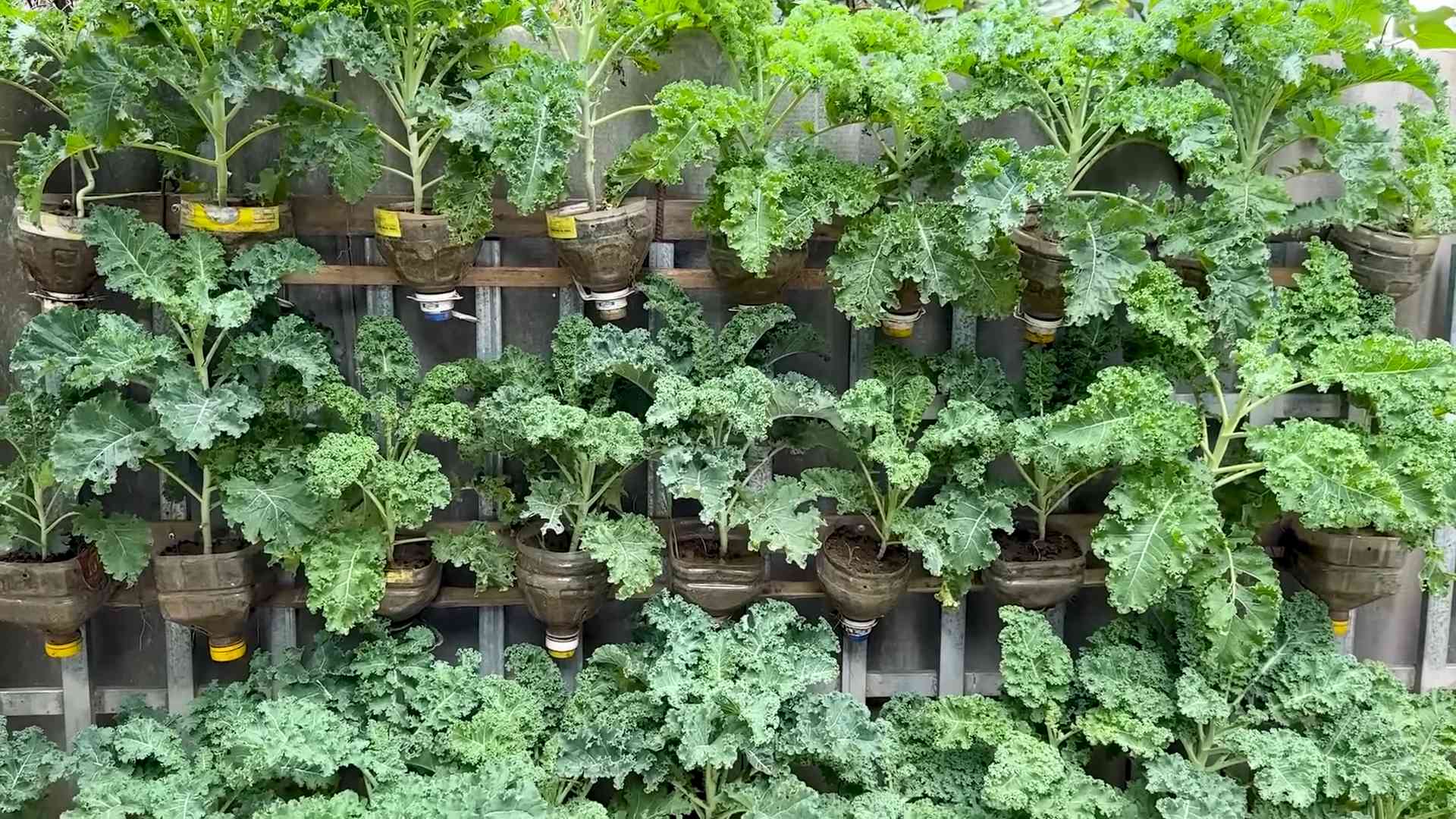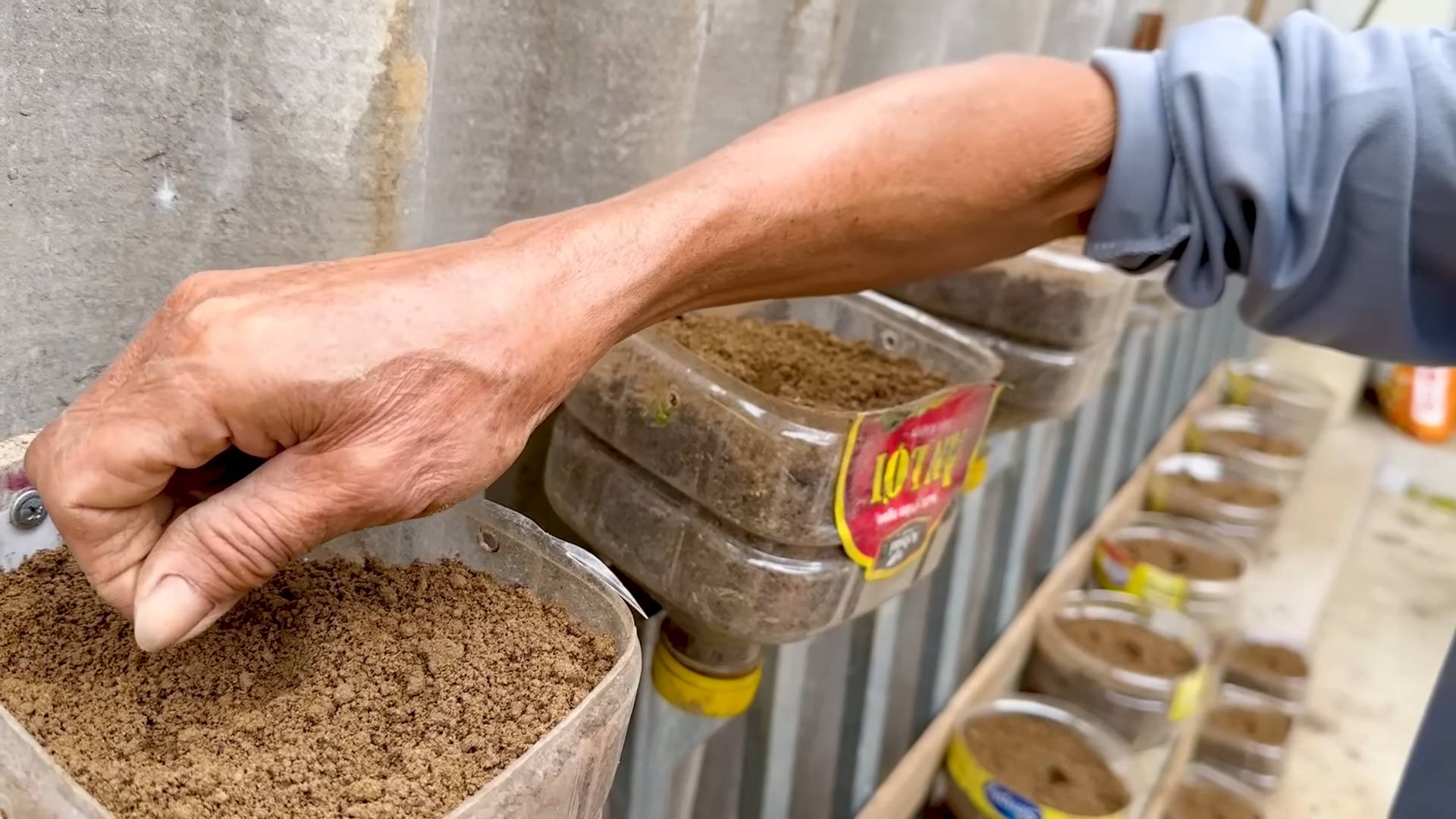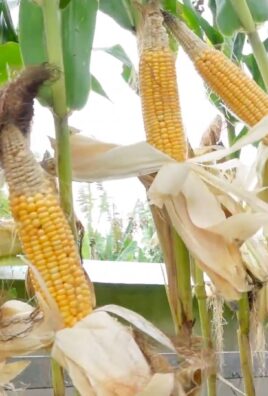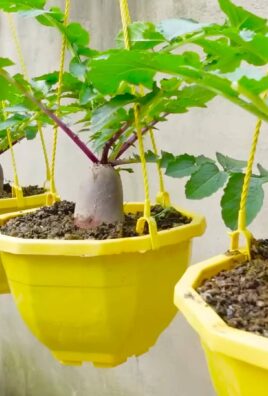Grow kale in plastic bottles? Absolutely! I know it sounds a little unconventional, but trust me, this ingenious DIY trick is a game-changer for anyone looking to maximize their gardening space and enjoy fresh, homegrown kale, even without a sprawling backyard. For centuries, resourceful gardeners have been finding innovative ways to cultivate food in limited spaces. From ancient rooftop gardens in Babylon to the modern-day vertical farms, the desire to connect with nature and grow our own food has always driven human ingenuity.
But why should you bother growing kale in a plastic bottle? Well, think about it: limited space, budget-friendly, and incredibly eco-conscious! This method is perfect for apartment dwellers, balcony gardeners, or anyone looking to reduce waste by repurposing plastic bottles. Plus, it’s a fantastic way to introduce kids to the joys of gardening and teach them about sustainability. Imagine the satisfaction of harvesting your own vibrant, nutrient-rich kale, knowing you nurtured it from a tiny seed, all within a recycled plastic bottle.
This DIY project isn’t just about growing kale; it’s about embracing a sustainable lifestyle, connecting with nature, and enjoying the delicious rewards of your own hard work. So, let’s dive in and discover how easy it is to grow kale in plastic bottles and transform your space into a thriving mini-garden!

DIY Vertical Kale Garden: Upcycling Plastic Bottles
Hey there, fellow gardeners! I’m super excited to share this awesome DIY project with you: creating a vertical kale garden using recycled plastic bottles. Not only is this a fantastic way to grow your own fresh, healthy kale, but it’s also a brilliant way to reduce plastic waste. Plus, it’s a space-saver, perfect for balconies, patios, or even small indoor spaces. Let’s get started!
What You’ll Need:
Before we dive in, let’s gather all the necessary materials. Trust me, having everything ready beforehand will make the whole process much smoother.
* Plastic Bottles: You’ll need several plastic bottles (2-liter soda bottles or similar work great). The number depends on how big you want your vertical garden to be. Make sure they’re clean and dry.
* Kale Seeds or Seedlings: Choose your favorite kale variety! I personally love curly kale and dinosaur kale.
* Potting Soil: A good quality potting mix is essential for healthy kale growth.
* Scissors or Utility Knife: For cutting the plastic bottles. Be careful!
* Drill or Awl: To create drainage holes and hanging points.
* Rope or Twine: For hanging the bottles vertically. Jute twine looks really nice.
* Measuring Tape or Ruler: To ensure consistent cuts and spacing.
* Marker or Pen: For marking cutting lines.
* Gloves: To protect your hands.
* Watering Can or Spray Bottle: For watering your kale.
* Optional: Decorative paint or stickers to personalize your bottles.
Preparing the Plastic Bottles
This is where we transform those ordinary plastic bottles into mini kale planters!
1. Clean the Bottles: Start by thoroughly cleaning the plastic bottles with soap and water. Remove any labels and sticky residue. Rinse them well and let them dry completely. This is important to prevent any mold or bacteria growth.
2. Cut the Bottles: This is the trickiest part, so take your time and be careful.
* Mark the Cutting Line: Using your marker and ruler, draw a horizontal line around each bottle. This line should be about one-third of the way down from the top of the bottle. This will create a reservoir for water and allow the kale roots to grow downwards.
* Cut Along the Line: Carefully cut along the marked line using your scissors or utility knife. I find that starting with a small puncture and then following the line works best. You’ll end up with two pieces: the top part (which we’ll discard or recycle) and the bottom part (which will be our planter).
* Smooth the Edges: The cut edges can be sharp, so smooth them down with sandpaper or a file. This will prevent any accidental cuts when you’re handling the planters.
3. Create Drainage Holes: Kale needs good drainage to thrive.
* Drill or Poke Holes: Use your drill or awl to create several small drainage holes in the bottom of each bottle. I usually make about 4-5 holes, evenly spaced.
* Check for Blockages: Make sure the holes are clear and not blocked by any plastic debris.
4. Create Hanging Points: Now we need to create a way to hang the bottles.
* Drill or Poke Holes: Drill or poke two holes on opposite sides of the bottle, near the top edge. These holes should be large enough to thread your rope or twine through.
* Reinforce the Holes (Optional): For added strength, you can reinforce the holes with metal grommets or washers. This will prevent the plastic from tearing over time.
Planting the Kale
Time to get our hands dirty and plant some kale!
1. Fill with Potting Soil: Fill each bottle with high-quality potting soil, leaving about an inch of space at the top. Gently pat down the soil to remove any air pockets.
2. Plant the Seeds or Seedlings:
* From Seeds: If you’re starting from seeds, sow a few seeds in the center of each bottle, following the instructions on the seed packet. Cover the seeds with a thin layer of soil and gently water them.
* From Seedlings: If you’re using seedlings, carefully remove them from their containers and gently loosen the roots. Dig a small hole in the center of each bottle and plant the seedling, making sure the top of the root ball is level with the soil surface. Gently water the seedling.
3. Water Thoroughly: After planting, water the kale thoroughly until the water drains out of the drainage holes. This will help settle the soil and encourage root growth.
Assembling the Vertical Garden
Now for the fun part: putting it all together!
1. Cut the Rope or Twine: Cut several lengths of rope or twine, depending on how long you want your vertical garden to be. Remember to leave some extra length for tying knots.
2. Thread the Rope: Thread the rope through the hanging holes in each bottle. You can create a single strand of bottles or multiple strands, depending on your preference.
3. Tie Knots: Tie secure knots at the bottom of each bottle to prevent them from sliding down the rope. You can also tie knots above each bottle to create consistent spacing. I like to space mine about 6-8 inches apart.
4. Hang Your Garden: Find a sunny spot to hang your vertical kale garden. Make sure the location receives at least 6 hours of sunlight per day. You can hang it from a balcony railing, a fence, or even a sturdy hook on your patio.
Caring for Your Kale
Now that your vertical kale garden is up and running, here’s how to keep your kale plants happy and healthy.
1. Watering: Kale needs consistent moisture, but avoid overwatering. Water when the top inch of soil feels dry to the touch. Water thoroughly until the water drains out of the drainage holes. In hot weather, you may need to water more frequently.
2. Fertilizing: Kale is a heavy feeder, so it needs regular fertilization. Use a balanced liquid fertilizer every 2-3 weeks, following the instructions on the fertilizer label. You can also add compost or worm castings to the soil to provide extra nutrients.
3. Sunlight: Kale needs at least 6 hours of sunlight per day to thrive. If you’re growing your kale indoors, you may need to supplement with artificial light.
4. Pest Control: Keep an eye out for pests like aphids, cabbage worms, and slugs. You can control these pests with organic methods like handpicking, insecticidal soap, or diatomaceous earth.
5. Harvesting: You can start harvesting kale leaves when they are about 4-6 inches long. Simply cut the outer leaves, leaving the inner leaves to continue growing. Regular harvesting will encourage the plant to produce more leaves.
Troubleshooting
Even with the best care, you might encounter some problems. Here are a few common issues and how to address them:
* Yellowing Leaves: This could be a sign of overwatering, underwatering, or nutrient deficiency. Check the soil moisture and adjust your watering schedule accordingly. Fertilize with a balanced fertilizer to provide essential nutrients.
* Leggy Growth: This usually indicates insufficient sunlight. Move your kale garden to a sunnier location or supplement with artificial light.
* Pest Infestation: Inspect your plants regularly for pests. Treat infestations promptly with organic pest control methods.
* Slow Growth: This could be due to poor soil quality or insufficient nutrients. Amend the soil with compost or worm castings and fertilize regularly.
Personalizing Your Garden
One of the best things about this DIY project is that you can personalize it to your heart’s content!
* Paint the Bottles: Use acrylic paint to decorate the bottles with colorful designs or patterns.
* Add Labels: Label each bottle with the type of kale you’re growing.
* Use Different Colored Twine: Choose twine in your favorite colors to add a pop of personality.
* Add Decorative Elements: Hang small ornaments or wind chimes near your garden to create a whimsical atmosphere.
Enjoying Your Harvest
The best part of growing your own kale is enjoying the delicious and nutritious harvest! Kale is incredibly versatile and can be used in a variety of dishes.
* Salads: Add chopped kale to your favorite salads for a boost of vitamins and minerals.
* Smoothies: Blend kale into your smoothies for a healthy and refreshing drink.
* Soups and Stews: Add kale to soups and stews for added flavor and nutrients.
* Chips: Bake kale leaves into crispy and delicious kale chips.
* Sautéed Kale: Sauté kale with garlic and olive oil for a simple and healthy side dish.
I hope you enjoyed this DIY

Conclusion
So, there you have it! Growing kale in plastic bottles isn’t just a quirky gardening experiment; it’s a practical, sustainable, and incredibly rewarding way to enjoy fresh, homegrown greens, even if you’re short on space or gardening experience. We’ve shown you how to transform discarded plastic bottles into thriving miniature kale gardens, minimizing waste and maximizing your access to nutritious food.
But why is this DIY trick a must-try? Beyond the obvious environmental benefits of recycling, growing kale in plastic bottles offers several compelling advantages. First, it’s incredibly space-efficient. Whether you have a sprawling backyard or a tiny balcony, you can easily accommodate several bottle gardens. Second, it’s cost-effective. You’re repurposing materials that would otherwise end up in the landfill, significantly reducing the cost of traditional gardening. Third, it’s a fantastic way to control the growing environment. You can easily move your bottle gardens to optimize sunlight exposure or protect them from harsh weather conditions. Fourth, it’s a fun and educational project for the whole family, teaching valuable lessons about sustainability, plant growth, and healthy eating.
Now, let’s talk about variations. While we’ve focused on kale, this method can be adapted for other leafy greens and herbs. Consider experimenting with spinach, lettuce, arugula, or even herbs like basil, parsley, or mint. The key is to choose plants with relatively shallow root systems that can thrive in the limited space of a plastic bottle. You can also get creative with the design of your bottle gardens. Try painting the bottles to add a splash of color to your space, or create a vertical garden by hanging the bottles from a wall or fence. For added nutrients, consider adding compost tea to your watering routine. This will provide your kale plants with a boost of essential minerals and promote healthy growth. You can also experiment with different types of soil mixes to find what works best for your local climate and growing conditions.
Don’t be afraid to experiment with different varieties of kale as well. Curly kale, dinosaur kale (lacinato), and red Russian kale all offer unique flavors and textures. Growing different varieties will add variety to your meals and allow you to discover your favorite type of kale. Remember to monitor your plants regularly for pests and diseases. While kale is generally a hardy plant, it can be susceptible to aphids, cabbage worms, and other common garden pests. If you notice any signs of infestation, take action promptly to prevent the problem from spreading. Organic pest control methods, such as neem oil or insecticidal soap, are often effective.
Ultimately, the success of your bottle garden depends on your willingness to experiment and adapt. Don’t be discouraged if your first attempt isn’t perfect. Gardening is a learning process, and every mistake is an opportunity to improve. The most important thing is to have fun and enjoy the process of growing your own food.
We wholeheartedly encourage you to try this DIY trick and experience the joy of growing your own kale in plastic bottles. It’s a simple, sustainable, and rewarding way to connect with nature and enjoy fresh, healthy food. Once you’ve given it a try, we’d love to hear about your experience! Share your photos, tips, and challenges in the comments below. Let’s create a community of bottle gardeners and inspire others to embrace sustainable living. We are confident that you will find that growing kale in plastic bottles is a rewarding experience.
Frequently Asked Questions
What kind of plastic bottles are best for growing kale?
Ideally, you should use food-grade plastic bottles, such as those used for water, juice, or soda. Avoid using bottles that have contained harsh chemicals or cleaning products, as these could contaminate the soil and harm your plants. Look for bottles that are relatively clear, as this will allow sunlight to reach the roots of your kale plants. The size of the bottle will depend on the variety of kale you’re growing, but generally, a 2-liter bottle is a good starting point. Make sure to thoroughly clean the bottles before using them to remove any residue or debris.
How often should I water my kale plants in plastic bottles?
The frequency of watering will depend on several factors, including the weather, the type of soil you’re using, and the size of the bottle. As a general rule, you should water your kale plants whenever the top inch of soil feels dry to the touch. Avoid overwatering, as this can lead to root rot. When watering, make sure to saturate the soil thoroughly, allowing excess water to drain out of the drainage holes. During hot, dry weather, you may need to water your plants more frequently. Check the soil moisture regularly and adjust your watering schedule accordingly.
What type of soil is best for growing kale in plastic bottles?
A well-draining potting mix is essential for growing healthy kale plants in plastic bottles. Avoid using garden soil, as it can be too heavy and compacted, which can hinder drainage and suffocate the roots. A good potting mix should contain a blend of peat moss, perlite, and vermiculite. You can also add compost to the mix to provide additional nutrients. Make sure the soil is loose and airy to allow for proper root growth. You can also amend the soil with slow-release fertilizer to provide a steady supply of nutrients to your kale plants.
How much sunlight do kale plants need?
Kale plants need at least 6 hours of sunlight per day to thrive. Choose a location for your bottle gardens that receives plenty of direct sunlight. If you live in a hot climate, you may need to provide some afternoon shade to prevent the leaves from scorching. If you’re growing your kale plants indoors, you’ll need to supplement with artificial light. Grow lights are a great option for providing the necessary light for indoor plants. Position the lights close to the plants and adjust the height as they grow.
How do I prevent pests and diseases from affecting my kale plants?
Regularly inspect your kale plants for signs of pests and diseases. Aphids, cabbage worms, and flea beetles are common pests that can affect kale. You can control these pests with organic pest control methods, such as neem oil, insecticidal soap, or diatomaceous earth. To prevent diseases, make sure to provide good air circulation and avoid overwatering. Remove any dead or diseased leaves promptly to prevent the spread of disease. Crop rotation can also help to prevent soilborne diseases.
When is the best time to harvest kale?
You can start harvesting kale leaves when they are about 4-6 inches long. Harvest the outer leaves first, leaving the inner leaves to continue growing. Avoid harvesting more than one-third of the plant at a time, as this can stress the plant and reduce its yield. Kale leaves are most tender and flavorful when harvested in the morning. You can store harvested kale leaves in the refrigerator for up to a week.
Can I grow kale in plastic bottles indoors?
Yes, you can grow kale in plastic bottles indoors, but you’ll need to provide adequate light. A sunny windowsill may be sufficient, but you may need to supplement with artificial light, especially during the winter months. Make sure to rotate the bottles regularly to ensure that all sides of the plant receive equal light exposure. Indoor kale plants may also require more frequent watering, as the air indoors tends to be drier.
How do I fertilize my kale plants in plastic bottles?
Kale plants are heavy feeders and require regular fertilization. You can use a balanced liquid fertilizer or a slow-release granular fertilizer. Follow the instructions on the fertilizer package carefully. Avoid over-fertilizing, as this can burn the roots of the plants. You can also add compost tea to your watering routine to provide additional nutrients. Compost tea is a natural and effective way to fertilize your kale plants.
What are some creative ways to display my kale bottle gardens?
There are many creative ways to display your kale bottle gardens. You can hang them from a wall or fence to create a vertical garden. You can also arrange them on a table or shelf to create a miniature garden display. Get creative with the design of your bottle gardens by painting the bottles or adding decorative elements. You can also use different sizes and shapes of bottles to create a visually appealing display.
Is growing kale in plastic bottles sustainable?
Yes, growing kale in plastic bottles is a sustainable practice. It repurposes materials that would otherwise end up in the landfill, reduces the need for transportation of produce, and allows you to grow your own food locally. By growing your own kale, you can reduce your carbon footprint and contribute to a more sustainable food system. It’s a win-win for you and the environment.





Leave a Comment